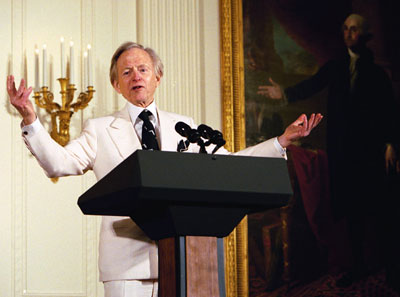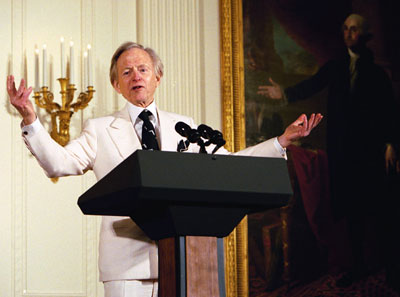[ad_1]

Tom Wolfe.
VIA WIKIMEDIA COMMONS
Tom Wolfe, the writer famous for his stylish analyses of various cultural phenomena, died yesterday at 88, according to the New York Times. Wolfe had, over the course of his career, made major contributions to the field of journalism and literature, writing such important books as the novel Bonfire of the Vanities (1987), a gimlet-eyed takedown of upper-class New York society, and The Electric Kool-Aid Acid Test (1968), a nonfiction book that contended with hippie culture during the ’60s.
He also penned one of the most important art books of the 20th century: The Painted Word (1975), an essential tome that argued that, in the transition between modernism and what would ultimately be called postmodernism, during the 1950s, ’60s, and ’70s, a group of critics had made it so that artworks mattered less than the texts that were produced surrounding them. Words, in his view, became more important than objects. Here is one of the book’s most excoriating passages, from its introduction:
All these years I, like so many others, had stood in front of a thousand, two thousand, God-knows-how-many thousand Pollocks, de Koonings, Newmans, Nolands, Rothkos, Rauschenbergs, Judds, Johnses, Olitskis, Louises, Stills, Franz Klines, Frankenthalers, Kellys, and Frank Stellas, now squinting, now popping eye sockets open, now drawing back, now moving closer—waiting, waiting, forever waiting for . . . it . . . for it to come into focus, namely, the visual reward (for so much effort) which must be there, which everyone (tout le monde) knew to be there—waiting for something to radiate directly from the paintings on these invariably white walls, in this room, in this moment, onto my own optic chiasma. All these years, in short, I had assumed that in art, if nowhere else, seeing is believing. Well—how very shortsighted! Now, at least, on April 28, 1974, I could see. I had gotten it backward all along. Not “seeing is believing,” you ninny, but “believing is seeing,” for Modern Art has become completely literary: the paintings and other works exist only to illustrate the text.
Over the course of his life, Wolfe continually proved himself an adept observer of the art world. In 2015, in a conversation with the artist Tom Sachs, Wolfe said:
I love the phrase ‘the art world.’ The art world, I figure, is made up of—I used to give the figure of 10,000 people worldwide. It’s a little more now. But about 3,000 of them live in the United States. Twenty-seven hundred of those live in or close to New York. That’s probably changed a little bit. And the idea that the public is trying to act on great art is a laughable theory. Because they don’t see great art. The 3,000, let’s say that’s the correct number in New York, they’re least of all critics. The critics are messenger boys today. They just get the news from the art world and they bring it to the newspapers. When’s the last time you saw a critic in a newspaper or magazine saying ‘This is the greatest’ when no one else is agreeing? It doesn’t happen anywhere. It used to happen. Critics made a point of going head to head, but no longer. I think that’s a shame. The art world is made up of curators, collectors, and gallery owners, and some artists. They make all of the decisions. It’s not a world! It’s a community. Another thing today that I noticed, you talk about money in art. Very wealthy collectors have a tremendous impact. Art is a commodity, but it is the only commodity where everything is unique.
[ad_2]
Source link

